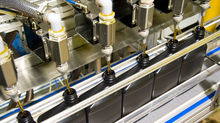The Truth About PAG / Polyol Ester Fluids

Generic, OEM-equivalent, industrial air compressor lubricants are widely available from a variety of sources across aftermarket suppliers and distributors. At Simple Air Performance, we want you to know the benefits of finding a supplier who will provide you and your customers with "true" high quality replacement oil where low price does not factor into compressor air end performance.
What are the OEM fluids such as Sullube* and Ultra Coolant**?
For almost 30 years Ingersoll Rand and Sullair have used PAG/Polyol ester blends as the primary factory fill in new rotary screw compressors. These are excellent fluids, which have been proven to be varnish free and be long life products. These fluids are composed of a blend of Polyalkylene Glycol with Polyol Ester. The polyglycol is an excellent long life lubricant, and this type of ester is fairly hydrolytically stable.
What are the benefits of a true Polyalkylene Glycol / Polyol Ester blend?
Varnish Free – Varnish is the enemy of the compressor; it plugs bearing orifices, cooler tubes, thermal blocks, and separators.
Long Life – A true PAG / Polyol Ester is typically rated from 8,000 to 10,000 hours. Some of today’s PAGs are proven at up to 16,000 hours with new additive technologies. Ingersoll Rand is currently offering a new PAG that has a rated life of 16,000 hours.
Corrosion – PAGs offer excellent corrosion protection, as all compressors have some water and rust. Water and rust are a major concern.
Low Carry Over – The fluid needs to stay in the compressor, not go down stream into the process. PAG / Polyol Esters are excellent at preventing excessive carryover.
High Flash Point – With a rotary screw compressor, “Thermal Events” are always a concern. PAG / Polyol Ester offers a very high flash point, which reduces the likelihood of an undesirable event from occurring in your compressor.
Are there generic equivalents to the OEM fluids?
Yes But – Not all generics are truly equivalents. To get a true equivalent the fluid needs to be made up of approximately 80% Polyalkylene Glycol, 20% Polyol Ester, and the proper additive package.
PAG Replacements – Some PAG replacements don’t even use Polyalkylene Glycol in their fluids; they use a high amount of diester. They will call it a “PAG Replacement” or any number of other names. These “PAG Replacement” formulations normally do not contain any Polyalkylene Glycol or Polyol Ester, but do mix with a true PAG.
PAG Blends - PAG blends do contain Polyalkylene Glycol but only in the range of 10% to 50% and then use a large percentage of diester in their fluids. There are no mandates or regulations that state that a fluid has to contain a certain amount of an ingredient in order to claim it is the main base stock. So a company can use a small amount of Polyglycol and tell their customers that they are buying a fluid just like the OEM lubricants.
What should I expect to pay for a “genuine” generic replacement?
True Equivalent – The true PAG lubricants will not be the cheapest option available with aftermarket suppliers, but can easily save half the expense of OEM PAG offerings. These true PAG equivalents will still offer the same benefits as the OEM products.
Cross Reference - It's always a good idea to make sure you are comparing apples to apples. Product comparison charts for OEM and Aftermarket fluids are available on our website.
* Sullube is a registered trademark of Sullair Corporation
** Ultra Coolant is a registered trademark of Ingersoll Rand Corporation





















